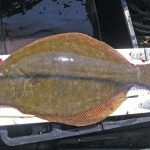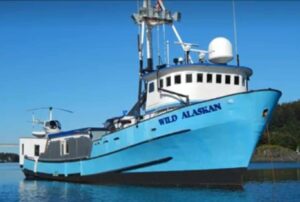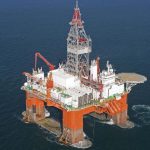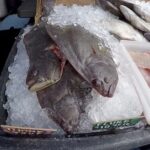Category Archives: Maine Science

Something ‘fishy’ about state’s herring data, argues a former Sitkan
The Sitka Sound Sac Roe Herring Fishery closed last week, but not before harvesting around 16,000 tons of herring, the biggest commercial harvest in nearly a decade. Commercial fishermen want the lucrative fishery to continue. And while the state is in the middle of a lawsuit with the Sitka Tribe of Alaska over the management of the fishery, the state maintains that its model is conservative. But the model has its critics. >click to read< Was the 2021 Sitka herring fishery built on irrelevant data? Was a slaughter of older herring the result? How risky could that be, anyhow? fishy numbers: an inquiry – Peter Bradley >click to read<14:55

Study: Microplastic fiber pollution harms lobster larvae
A study published in the Marine Pollution Bulletin reports that the fibers affect the animals’ feeding and respiration, and they could even prevent some larvae from reaching adulthood. “Lobsters play a fundamental role in the Gulf of Maine ecosystem as well as the state’s economy, and it is important that we understand how pollutants impact their development.” Young lobsters grow to adulthood through four distinct developmental stages, and the researchers found that the physiology of each stage determined how the animals interacted with plastic fibers. The youngest lobsters didn’t consume them—but they were plagued by fibers accumulating under the shells that protect their gills. >click to read< 16:04

New Environmental Defence Fund Report Details Actions Needed to Create Climate-Ready Fisheries
“Even with the necessary actions to control emissions and investments to reduce carbon dioxide already in the atmosphere, changes in the ocean already underway will continue and even accelerate,” said Eric Schwaab, senior vice president for EDF Oceans.,,, The five pathways articulated in the report focus on steps that can and must be taken by governments, NGOs, fisher organizations, academia and multilateral organizations in order to create greater resilience and sustainability of fisheries. The pathways include: >click to read< 06:57

Gulf of Maine lobster boom over as population starts to decline
The Gulf of Maine lobster population will shrink 40 to 62 percent over the next 30 years because of rising ocean temperatures, according to a new study released Monday. As the water temperature rises – the northwest Atlantic ocean is warming at three times the global average rate – the number of lobster eggs that survive their first year of life will decrease, and the number of small-bodied lobster predators that eat those that remain will increase. Those effects will cause the lobster population to fall through 2050, according to a study by scientists at the Gulf of Maine Research Institute, University of Maine and National Ocean and Atmospheric Administration. >click here to read< 19:49 

Trawl Surveys, what are they good for? – Nils E. Stolpe/FishNet USA
(Note that I am only addressing the NOAA/NMFS reliance on bottom trawl survey data in finfish stock assessments. I am not questioning the value of the wealth of biological and physical data that this long – running series of surveys generate.) From the article: According to NOAA/NMFS these surveys have provided and continue to provide “the primary scientific data” for fisheries assessments from North Carolina to Maine (fisheries assessments are the periodic – generally held every 3 to 5 years – scientific/bureaucratic exercises. In NOAA’s words “NOAA Fisheries’ scientific stock assessments are critical to modern fisheries management. Using data gathered from commercial and recreational fishermen and our own on-the-water scientific observations, a stock assessment describes the past and current status of a fish population or stock, answers questions about the size of the stock, and makes predictions about how a fishery will respond to current and future management measures.”) click here to read the article 12:35

Pyrosomes: The Borg of the ocean, clogging fishing and research gear
A strange organism has taken over the ocean waters off Oregon this spring, clogging fishing and research gear and confounding beachcombers and biologists. Fishermen compare them to pickles, gummy bears and sea cucumbers. They are the Borg of the ocean, one researcher suggested, referencing characters from the “Star Trek” TV show. They are called pyrosomes, and they are everywhere. In all his decades doing survey and research work off the coast, Richard Brodeur, research fishery biologist with the National Oceanic and Atmospheric Administration, has never encountered pyrosomes in these kinds of numbers, or really at all. He knew about them, had seen them down in California, but never off the Oregon Coast. Then, “starting in 2014, we started seeing a few of them,” he said. In 2015 and 2016, he saw a few more. This spring, on a survey cruise, they pulled up 60,000 pyrosomes in a five-minute tow. click here to read the story 15:15

Benjamin Franklin Was the First to Chart the Gulf Stream

A Big Decline of River Herring – Tiny stones in fish hold clues to help restore populations
Many New Englanders still recall the vast springtime runs of river herring. Millions of the small silvery fish swam up coastal freshwater streams, returning from the sea to spawn. Two species of river herring, alewives and blueback herring, are critical components of marine food webs, right up to the fishermen on shore and at sea who harvest them. But in the late 1960s, herring populations sharply declined to as little as one percent of their historic size. Ever more-efficient commercial fishing fleets have swept them up in coastal waters. But even after states banned or limited catches, the fish have not rebounded. To expand access to historical spawning habitats, some communities have also begun removing dams. In 2014, Joel Llopiz launched a project, funded by Woods Hole Sea Grant, with colleagues at the Massachusetts Division of Marine Fisheries. The researchers are collecting and examining larval herring in four coastal river/pond systems of different sizes in Massachusetts. The systems also vary in their impacts from pollution, urban development, and agriculture. Continue reading here with more images 15:42
Are big ups and downs normal for forage fish?
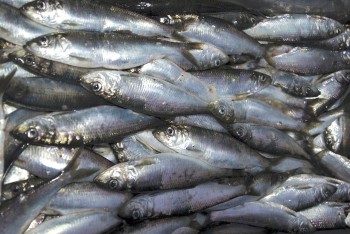 Forage fish stocks have undergone fluctuation swings for hundreds of years, research shows, with at least three species off the US West Coast repeatedly experiencing steep population increases followed by declines long before commercial fishing began. The rise and fall of Pacific sardine, northern anchovy, and Pacific hake off California have been so common that the species were in collapsed condition 29 to 40 percent of the time over the 500-year period from CE 1000 to 1500, according to a new study in Geophysical Research Letters. Using a long time series of fish scales deposited in low-oxygen, offshore sedimentary environments off Southern California, researchers described such collapses as “an intrinsic property of some forage fish populations that should be expected, just as droughts are expected in an arid climate.” Continue reading the article here 07:55
Forage fish stocks have undergone fluctuation swings for hundreds of years, research shows, with at least three species off the US West Coast repeatedly experiencing steep population increases followed by declines long before commercial fishing began. The rise and fall of Pacific sardine, northern anchovy, and Pacific hake off California have been so common that the species were in collapsed condition 29 to 40 percent of the time over the 500-year period from CE 1000 to 1500, according to a new study in Geophysical Research Letters. Using a long time series of fish scales deposited in low-oxygen, offshore sedimentary environments off Southern California, researchers described such collapses as “an intrinsic property of some forage fish populations that should be expected, just as droughts are expected in an arid climate.” Continue reading the article here 07:55
At NOAA – Trump team may emphasize climate science uncertainty
 The uncertainty surrounding climate research could be emphasized at the National Oceanic and Atmospheric Administration under the Trump Administration. The Trump Administration landing team at NOAA may focus on data used by the agency to formulate its climate research, calling into question the accuracy of temperature measurements that inform the public’s understanding of global warming, according to an official involved in preliminary talks. In particular, the team has discussed the ways that the instrumentation used in some NOAA temperature readings could be flawed and has raised the possibility of including a section on the NOAA online home page that would emphasize uncertainty.,, Sterling Burnett, a research fellow at the Heartland Institute, argued that the administration is not interested in stifling climate science so much as shifting research to other fields like short-term weather predictions and maintaining the health of commercial fishing stocks. He said scientists are going to have to get used to the idea of facing more scrutiny, particularly if they want to receive federal research grants, and predicted cuts to those grants as money is shifted to other fields he called more relevant to the economy. Read the article here 20:05
The uncertainty surrounding climate research could be emphasized at the National Oceanic and Atmospheric Administration under the Trump Administration. The Trump Administration landing team at NOAA may focus on data used by the agency to formulate its climate research, calling into question the accuracy of temperature measurements that inform the public’s understanding of global warming, according to an official involved in preliminary talks. In particular, the team has discussed the ways that the instrumentation used in some NOAA temperature readings could be flawed and has raised the possibility of including a section on the NOAA online home page that would emphasize uncertainty.,, Sterling Burnett, a research fellow at the Heartland Institute, argued that the administration is not interested in stifling climate science so much as shifting research to other fields like short-term weather predictions and maintaining the health of commercial fishing stocks. He said scientists are going to have to get used to the idea of facing more scrutiny, particularly if they want to receive federal research grants, and predicted cuts to those grants as money is shifted to other fields he called more relevant to the economy. Read the article here 20:05
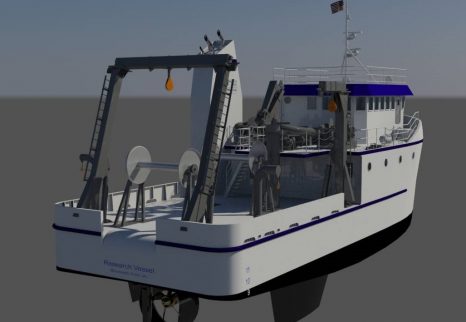
Virginia Institute of Marine Science Orders Research Vessel
Virginia Institute of Marine Science of Gloucester Point, Va. awarded a contract to Meridien Maritime Reparation of Matane, Quebec to construct a 93-foot research vessel. JMS Naval Architects of Mystic, Conn. designed the research vessel to replace VIMS’s current vessel, the R/V Bay Eagle. The primary mission of the Institute’s fleet is to provide inshore and offshore work platforms for the support of fisheries related oceanographic research projects. The new vessel will be capable of conducting fisheries assessments of greater capacity, in deeper waters and with a larger science complement than the Bay Eagle. In addition, the new vessel will greatly expand VIMS’s capability to perform general oceanographic research in the Chesapeake Bay and the mid-Atlantic near coastal waters. The state-of-the-art research vessel offers enormous capability in a small package that is also economic to build and operate. Read the rest here 13:28

There are more fish in the sea – A high-tech battle for the future of the New England fishing industry
The high-tech battle for the future of the Massachusetts fishing industry is being waged aboard a western-rigged stern trawler named the Miss Emily. Onboard the commercial groundfish vessel, in addition to the satellite positioning system and other sophisticated tools that have become standard in the industry, are at least five computer monitors and a $14,000 fish-measuring board that has halved the time it takes to gauge the catch. State officials say it’s money well spent. Federal catch limits — caps on how many fish each boat can catch — have devastated the state’s most iconic commercial sector, fishermen say. In response to an outcry from the struggling local groundfishing industry, environmental officials are now using the Miss Emily to try to come up with a new — and, they say, more accurate — estimate of codfish in the Gulf of Maine. Under a survey launched last April, local fishermen hope new technology and an aggressive timetable will yield what they have concluded based on their own anecdotal evidence: There are more fish in the sea. Read the story here 09:59
How False killer whale’s remove bait from longline fishing gear captured on video for first time
 How Hawaiian false killer whales remove fish from longline fishing gear has for the first time been observed by a team of researchers and fishermen. The team, coordinated by Scripps Institution of Oceanography at the University of California San Diego scientist Aaron Thode, used video and audio recordings to observe false killer whales removing fish from a longline fishing hook, a behavior known as depredation. They gained new insight into a behavior that has caused false killer whales to entangle with fishing gear at rates deemed unsustainable by the U.S. National Marine Fisheries Service. To observe false killer whales removing fish from hooks, the Alaskan and Hawaiian research team deployed an underwater camera, sound recorder, and vibration detector on long-line fishing gear deployed by fishing vessels off Hawaii. Read the article here 16:40
How Hawaiian false killer whales remove fish from longline fishing gear has for the first time been observed by a team of researchers and fishermen. The team, coordinated by Scripps Institution of Oceanography at the University of California San Diego scientist Aaron Thode, used video and audio recordings to observe false killer whales removing fish from a longline fishing hook, a behavior known as depredation. They gained new insight into a behavior that has caused false killer whales to entangle with fishing gear at rates deemed unsustainable by the U.S. National Marine Fisheries Service. To observe false killer whales removing fish from hooks, the Alaskan and Hawaiian research team deployed an underwater camera, sound recorder, and vibration detector on long-line fishing gear deployed by fishing vessels off Hawaii. Read the article here 16:40
Ocean Pasture Plankton Collapse Cataclysmic Say German Media – Russ George responds
 DW reports (April 2016): Food chains represent the greatest interdependency within the webs of life. The marine food chain, for instance, is essential for oceans – and depends on plankton. But environmental changes and human activities may be threatening plankton – and therefore all marine animals. (Editors note: Indeed the most favoured explanation for the collapse of plankton that make up vital ocean pastures is the impact of high and rising CO2 which at once starves the ocean of vital nutrients while acidifying ocean waters such that microscopic life, the larva of fish and shellfish as well as plankton cannot thrive. Proven Technology To The Rescue. Here’s what happens when a few tens of thousands of dollars of mineral rich dust is spread in infinitesimal amounts on a dying ocean pasture. The pasture blooms and grows an abundant crop of plankton that plankton feeds all of ocean life and in the case of my demonstration project grew hundreds of millions of additional salmon. IT JUST WORKS! Read the post here 19:35
DW reports (April 2016): Food chains represent the greatest interdependency within the webs of life. The marine food chain, for instance, is essential for oceans – and depends on plankton. But environmental changes and human activities may be threatening plankton – and therefore all marine animals. (Editors note: Indeed the most favoured explanation for the collapse of plankton that make up vital ocean pastures is the impact of high and rising CO2 which at once starves the ocean of vital nutrients while acidifying ocean waters such that microscopic life, the larva of fish and shellfish as well as plankton cannot thrive. Proven Technology To The Rescue. Here’s what happens when a few tens of thousands of dollars of mineral rich dust is spread in infinitesimal amounts on a dying ocean pasture. The pasture blooms and grows an abundant crop of plankton that plankton feeds all of ocean life and in the case of my demonstration project grew hundreds of millions of additional salmon. IT JUST WORKS! Read the post here 19:35
U.S. Backs Away From Offshore Arctic Drilling
 On Friday, the Department of the Interior announced the cancellation of two potential lease sales off the Alaskan coast in the . The Bureau of Safety and Environmental Enforcement also denied lease extension requests from two companies, Shell and Statoil, that were exploring the seas for fossil fuels. Read the rest here 21:47
On Friday, the Department of the Interior announced the cancellation of two potential lease sales off the Alaskan coast in the . The Bureau of Safety and Environmental Enforcement also denied lease extension requests from two companies, Shell and Statoil, that were exploring the seas for fossil fuels. Read the rest here 21:47
Southern Flounder – Disputed fisheries studies: Politics or inexact science?
 Science plays a big role in managing fisheries. Scientists assess fish stocks, migration patterns, environmental issues — useful data that allow regulators to set policy. We expect our science to be accurate and unaffected by politics, and as citizens, we expect political actors to treat science in the same manner.,, Yet a series of e-mails found their way into the public domain from a 2007 round-robin discussion among several N.C. Division of Marine Fisheries scientists trying to peg a mortality rate for speckled seatrout caught by recreational anglers. See video It would take a few hundred words to demonstrate where science goes off the rails and how other factors, including interest group reactions, exert an influence on what is expected to be an unbiased, fact-driven process. Read the rest here 10:30
Science plays a big role in managing fisheries. Scientists assess fish stocks, migration patterns, environmental issues — useful data that allow regulators to set policy. We expect our science to be accurate and unaffected by politics, and as citizens, we expect political actors to treat science in the same manner.,, Yet a series of e-mails found their way into the public domain from a 2007 round-robin discussion among several N.C. Division of Marine Fisheries scientists trying to peg a mortality rate for speckled seatrout caught by recreational anglers. See video It would take a few hundred words to demonstrate where science goes off the rails and how other factors, including interest group reactions, exert an influence on what is expected to be an unbiased, fact-driven process. Read the rest here 10:30
New study suggests catching the slowest swimmers, commercial fishermen are inadvertently helping fish species evolve to swim faster.
Dr. Killen and his colleagues investigated whether commercial fishing was prompting physiological changes, as faster fish had better chances of evading capture by  . “Over time, the selective removal of poor-swimming fish could alter the fundamental physiological makeup of descendant populations that avoid fisheries capture,” explains Killen. “Fish being trawled will try to swim at a steady pace ahead of the mouth of the net for as long as possible, but a proportion will eventually tire and fall back into the net,” said Killen Read the rest here 12:24
. “Over time, the selective removal of poor-swimming fish could alter the fundamental physiological makeup of descendant populations that avoid fisheries capture,” explains Killen. “Fish being trawled will try to swim at a steady pace ahead of the mouth of the net for as long as possible, but a proportion will eventually tire and fall back into the net,” said Killen Read the rest here 12:24
Researchers conclude popular rockfish is actually two distinct species
 A new analysis confirms that the Blue Rockfish (Sebastes mystinus), a popular and commercially significant rockfish sought by anglers primarily off the California and Oregon coasts, is actually two separate and distinct species. “Black Rockfish are the major target of the complex and have a separate quota, set at 440 metric tons,” Wagman said. “But the Blue Rockfish quota is much lower and ODFW is concerned that if fishing efforts exceed that quota, then all groundfish fishing would have to stop in Oregon because even incidental catch and release of Blue Rockfish would exceed the quota.” Read the rest here 09:10
A new analysis confirms that the Blue Rockfish (Sebastes mystinus), a popular and commercially significant rockfish sought by anglers primarily off the California and Oregon coasts, is actually two separate and distinct species. “Black Rockfish are the major target of the complex and have a separate quota, set at 440 metric tons,” Wagman said. “But the Blue Rockfish quota is much lower and ODFW is concerned that if fishing efforts exceed that quota, then all groundfish fishing would have to stop in Oregon because even incidental catch and release of Blue Rockfish would exceed the quota.” Read the rest here 09:10
July 22 Meetings for Fishermen on Upcoming Groundfish Operational Assessments
 The NEFSC is holding outreach meetings on July 22 in Portland, Gloucester, Woods Hole, and New Bedford for fishermen interested in the upcoming operational assessments for 20 stocks of Northeast groundfish. Click link for information on webinar, meeting times and locations Two assessment analysts will be on hand to meet with interested fishermen, to learn more about recent observations from the fleet that might help focus future research to improve assessments. There will also be a short webinar on the timeline for the assessments, what new information will be considered, and how the results will be reviewed before they are sent into the fishery management process. Read the notice here
The NEFSC is holding outreach meetings on July 22 in Portland, Gloucester, Woods Hole, and New Bedford for fishermen interested in the upcoming operational assessments for 20 stocks of Northeast groundfish. Click link for information on webinar, meeting times and locations Two assessment analysts will be on hand to meet with interested fishermen, to learn more about recent observations from the fleet that might help focus future research to improve assessments. There will also be a short webinar on the timeline for the assessments, what new information will be considered, and how the results will be reviewed before they are sent into the fishery management process. Read the notice hereFishing boats become citizen science data platforms – What a Novel Idea!
 Prof Hart said that the current work is attempting to bridge the divide between scientists and commercial fishermen, allowing them to have a direct voice in the management and regulation of the waters they fish.”What we have essentially been doing is involving them in gathering data and eventually building a computer model of the crab fishery, which we hope then use later for conservation and sustainability studies,” “It should help them justify their activities in the face of management agency questions, and it also gives them more credibility when they are in negotiations with local management agencies. Read the rest here 11:18
Prof Hart said that the current work is attempting to bridge the divide between scientists and commercial fishermen, allowing them to have a direct voice in the management and regulation of the waters they fish.”What we have essentially been doing is involving them in gathering data and eventually building a computer model of the crab fishery, which we hope then use later for conservation and sustainability studies,” “It should help them justify their activities in the face of management agency questions, and it also gives them more credibility when they are in negotiations with local management agencies. Read the rest here 11:18
$10 Million budget Proposal to get better counts of Gulf red snapper makes headway
 The next time government researchers go out in boats to collect data on snapper with fishing lines and underwater cameras, they might have a flood of additional data to include in their fish count: information gathered by recreational anglers, charter boat captains and academic researchers. A $10 million budget proposal by U.S. Rep. David Jolly, R-Indian Shores, directs the federal fisheries service to award funds to everyone from commercial fishing operations to marine science laboratories for projects that collect data on fish populations. Read the rest here 09:46
The next time government researchers go out in boats to collect data on snapper with fishing lines and underwater cameras, they might have a flood of additional data to include in their fish count: information gathered by recreational anglers, charter boat captains and academic researchers. A $10 million budget proposal by U.S. Rep. David Jolly, R-Indian Shores, directs the federal fisheries service to award funds to everyone from commercial fishing operations to marine science laboratories for projects that collect data on fish populations. Read the rest here 09:46
Investigating how trawling affects the prey and diet composition of two flatfish species in the northeastern Irish Sea
 This article appears at mongabay.con, an environmental blog, written by Joanna Parkman. Read between the lines.- Investigating how trawling affects the prey and diet composition of two flatfish species, plaice (Pleuronectes platessa) and dab (Limanda limanda), Andrew Frederick Johnson, found that bottom trawling leaves plaice with reduced biomass. In other words, the fishing technique could be responsible for skinnier plaice. Read the rest here 17:22
This article appears at mongabay.con, an environmental blog, written by Joanna Parkman. Read between the lines.- Investigating how trawling affects the prey and diet composition of two flatfish species, plaice (Pleuronectes platessa) and dab (Limanda limanda), Andrew Frederick Johnson, found that bottom trawling leaves plaice with reduced biomass. In other words, the fishing technique could be responsible for skinnier plaice. Read the rest here 17:22
Audio Presentation: Eavesdropping on the Private Lives of Cod
 If you want to protect New England’s most iconic fish and still allow fishermen to catch them, it’s critical to know when and where they reproduce. The trouble is, we don’t. It turns out cod and humans may not be as different as you’d think. Chris McGuire, marine programs director for The Nature Conservancy, says cod spawning (a.k.a. baby-making) behavior is a lot like a night club scene. Read the rest here 13:02
If you want to protect New England’s most iconic fish and still allow fishermen to catch them, it’s critical to know when and where they reproduce. The trouble is, we don’t. It turns out cod and humans may not be as different as you’d think. Chris McGuire, marine programs director for The Nature Conservancy, says cod spawning (a.k.a. baby-making) behavior is a lot like a night club scene. Read the rest here 13:02
In the News -SMAST Prof. Emeritus Brian Rothschild Named Hjort Scholar
 SMAST Prof. Emeritus Brian Rothschild has been appointed a Hjort Scholar by the Hjort Centre for Marine Ecosystem Dynamics, Bergen, Norway. According to the appointment letter, recipients of Hjort Scholarships are “… scientists whose research is deemed to promote scientific innovation and understanding of marine ecosystem dynamics.” He is currently President and CEO of the Center for Sustainable Fisheries (CSF), a science-based, non-profit organization “devoted to the onservation of our fisheries resources and the economic development of our fishing communities.” Read the rest here 12:06
SMAST Prof. Emeritus Brian Rothschild has been appointed a Hjort Scholar by the Hjort Centre for Marine Ecosystem Dynamics, Bergen, Norway. According to the appointment letter, recipients of Hjort Scholarships are “… scientists whose research is deemed to promote scientific innovation and understanding of marine ecosystem dynamics.” He is currently President and CEO of the Center for Sustainable Fisheries (CSF), a science-based, non-profit organization “devoted to the onservation of our fisheries resources and the economic development of our fishing communities.” Read the rest here 12:06
Webinar on the Dids, Dos, Don’ts, and Developments of Data-Limited Catch LImits.
 Webinar starts at 14:00 EST – Presented by NOAA egg heads Dr. Jim Berkson, and Dr. Jason Cope . Info and link to webinar here 20:58
Webinar starts at 14:00 EST – Presented by NOAA egg heads Dr. Jim Berkson, and Dr. Jason Cope . Info and link to webinar here 20:58
Bluefin tuna found off Greenland suggest influence of climate change
Scientists in Denmark have made an unusual discovery in the normally chilly waters off the east coast of Greenland. Along with schools of mackerel, their research vessel brought in three bluefin tuna – a species known from the Mediterranean and in the Gulf Coast of Mexico. Read more here 17:35
Don’t throw away that fish waste!
 The disposal or reuse of fish processing waste has long been a challenge for Michigan’s fish processing industry. Approximately 5 million pounds of waste from commercially processed lake whitefish, lake trout, and salmon are generated, annually. <Read more here> 08:44
The disposal or reuse of fish processing waste has long been a challenge for Michigan’s fish processing industry. Approximately 5 million pounds of waste from commercially processed lake whitefish, lake trout, and salmon are generated, annually. <Read more here> 08:44
UPDATED: Maine’s shrimp fishery may face new restrictions
 Federal regulators, Atlantic States Marine Fisheries Commission, may limit the number of fishermen allowed to catch northern shrimp in the Gulf of Maine once the depleted fishery reopens. Read more here (Reading between the lines, here comes Catch Shares for this fishery!) 12:51
Federal regulators, Atlantic States Marine Fisheries Commission, may limit the number of fishermen allowed to catch northern shrimp in the Gulf of Maine once the depleted fishery reopens. Read more here (Reading between the lines, here comes Catch Shares for this fishery!) 12:51
Tracking endangered leatherback sea turtles by satellite, key habitats identified
 The study, part of doctoral research by Kara Dodge supervised by her advisor, Molly Lutcavage of the University of Massachusetts Amherst’s Large Pelagics Research Center (LPRC) in Gloucester, followed leatherbacks in their northern US feeding grounds. Read more here sciencedaily 08:16
The study, part of doctoral research by Kara Dodge supervised by her advisor, Molly Lutcavage of the University of Massachusetts Amherst’s Large Pelagics Research Center (LPRC) in Gloucester, followed leatherbacks in their northern US feeding grounds. Read more here sciencedaily 08:16




































